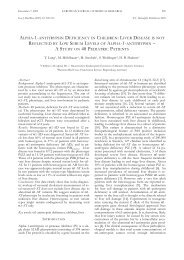European Journal of Medical Research - Deutsche AIDS ...
European Journal of Medical Research - Deutsche AIDS ...
European Journal of Medical Research - Deutsche AIDS ...
You also want an ePaper? Increase the reach of your titles
YUMPU automatically turns print PDFs into web optimized ePapers that Google loves.
114 EUROPEAN JOURNAL OF MEDICAL RESEARCH<br />
June 27, 2007<br />
E. Virologie<br />
E.1 (Vortrag)<br />
More than one interaction: GBV-C clinical isolates<br />
differ in the ability to interfere with entry and post<br />
entry replication steps <strong>of</strong> HIV<br />
Jung S. 1 , Tenckh<strong>of</strong>f S. 2 , Tillmann H. 2 , Müller R. 1 ,<br />
Hess G. 3 , Fleckenstein B. 1 , Reil H. 1<br />
1 Universitätsklinikum Erlangen, Virologisches Institut,<br />
Erlangen, Germany, 2 Universität Leipzig, Innere Medizin,<br />
Gastroenterologie, Leipzig, Germany, 3 Roche, Diagnostics,<br />
Mannheim, Germany<br />
Objective: The majority <strong>of</strong> clinical studies suggest a beneficial<br />
effect <strong>of</strong> GBV-C long-term viremia for HIV patients. In<br />
vitro studies reveal a direct influence <strong>of</strong> GBV-C on HIV replication.<br />
Recently we demonstrated that the GBV-C mediated<br />
HIV-inhibitory effect is not restricted to X4- or R5-tropic<br />
HIV isolates nor to different HIV clades. Now, we studied the<br />
HIV inhibitory capacity <strong>of</strong> different GBV-C isolates and the<br />
mechanism in more detail.<br />
Methods: GBV-C viremia and replication capacity <strong>of</strong> respective<br />
isolates were monitored by real-time RT-PCR. GBV-C<br />
phenotypes were determined in co-infection experiments. E2<br />
protein fused to the human IgG-Fc was expressed, purified<br />
and used to stimulate cells before HIV infection. A singleround-<strong>of</strong>-replication<br />
HIV assay was performed to differentiate<br />
between GBV-C mediated inhibition <strong>of</strong> early and later HIVreplication<br />
steps.<br />
Results: GBV-C isolates differ in the ability to suppress HIV<br />
replication and thus can be classified as HIV inhibitors and<br />
non-inhibitors. The different GBV-C phenotypes could be<br />
confirmed independently in a second laboratory, but do not<br />
correlate with their replication ability in vitro. The majority <strong>of</strong><br />
GBV-C isolates leads to suppression <strong>of</strong> HIV replication independent<br />
<strong>of</strong> entry. But in contrast, some GBV-C isolates interfere<br />
only with HIV entry and not with later steps. We could<br />
identify the GBV-C E2 protein to be responsible for HIV entry<br />
inhibition, but definitely not for post entry events. Therefore<br />
other probably nonstructural GBV-C proteins interfere<br />
with later HIV replication steps.<br />
Conclusions: Our results reveal that GBV-C mediated HIV<br />
impairment depends on different GBV-C proteins which interfere<br />
with several HIV replication steps. The GBV-C E2<br />
protein interferes exclusively with X4- and R5-HIV entry,<br />
whereas additionally other GBV-C components suppress post<br />
entry events. These findings could be supported by the fact<br />
that several GBV-C isolates differ in the degree <strong>of</strong> occurrences<br />
<strong>of</strong> these HIV-inhibitory attributes. The existence <strong>of</strong><br />
different HIV inhibitory phenotypes may explain the controversial<br />
epidemiological data on the influence <strong>of</strong> GBV-C for<br />
HIV progression in vivo. In addition, the identification <strong>of</strong> the<br />
E2 protein as a HIV entry-inhibitor may lead to new HIV<br />
therapeutics.<br />
E.2 (Vortrag)<br />
HIV cleavage site mutations in patients with<br />
failing protease-inhibitor therapies<br />
Verheyen J. 1 , Litau E. 1 , Schuldenzucker U. 2 , Oette M. 3 ,<br />
Fätkenheuer G. 4 , Rockstroh J. 5 , Stellbrink H.-J. 6 ,<br />
Däumer M. 1 , H<strong>of</strong>fmann D. 7 , Pfister H. 1 , Kaiser R. 1<br />
1 University <strong>of</strong> Cologne, Institute <strong>of</strong> Virology, Köln, Germany,<br />
2 caesar, Bonn, Germany, 3 University Clinic Düsseldorf, Clinic<br />
for Gastroenterology, Hepatology and infectious Diseases,<br />
Düsseldorf, Germany, 4 University <strong>of</strong> Cologne, Department <strong>of</strong><br />
Internal Medicine 1, Köln, Germany, 5 University <strong>of</strong> Bonn,<br />
Department <strong>of</strong> Internal Medicine 1, Bonn, Germany,<br />
6 Grindelpraxis, Hamburg, Germany, 7 University <strong>of</strong> Duisburg-<br />
Essen, Center for <strong>Medical</strong> Biotechnology, Essen, Germany<br />
HIV cleavage site (CS) mutations increasingly attract attention<br />
in the analysis Protease-Inhibitor (PI) resistance. More<br />
efficient cleavage <strong>of</strong> gag precursor proteins enhance replication<br />
under selective pressure <strong>of</strong> PIs and confer PI resistance.<br />
Although CS mutations could be correlated with different protease<br />
resistance pr<strong>of</strong>iles, knowledge about the occurrence <strong>of</strong><br />
CS mutations under selective pressure <strong>of</strong> certain PIs remained<br />
rudimentary.<br />
We analysed HIV <strong>of</strong> patients (n=195) under failing PI therapies<br />
(APV n=34, IDV n=17, LPV n=71, SQV n=28 or double<br />
PIs n = 22) with detectable viral loads in the pol gene as<br />
well as in the C-terminal gag region. PR/RT genotypes were<br />
interpreted with geno2pheno (www.genafor.org) and CS mutations<br />
were scored in comparison to HxB2. Statistical significance<br />
was determined using Fisher´s exact test (p





